An unpretentious frost-resistant variety of honeysuckle Berel
Honeysuckle, widespread in the forested areas of the middle zone, has increasingly begun to appear in our gardens. Among the cultivated species of this shrub, the unpretentious and frost-resistant Berel variety has earned particular popularity among summer residents.
Description of the honeysuckle variety Berel
This is a perennial deciduous shrub with tall (up to 2 m) erect shoots, forming a hemispherical crown with a diameter of about 1.5 m. Green young branches darken over time, acquiring a light brown color with a pinkish tint. Powerful skeletal stems are red-brown in color.
The plant has large, bright green leaf blades, slightly elongated, oval in shape, pubescent on the underside. At the top of the bushes they sometimes grow together or have a slightly curved shape. Stipules are small, almost invisible. The root system is powerful and well developed.
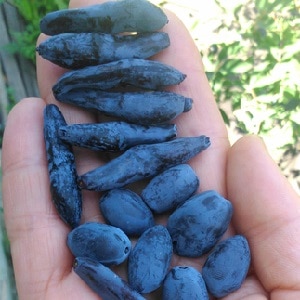 Large, white-pink, often irregularly shaped tubular buds are collected in small clusters. The flowering period occurs in May - June. In order for Berel honeysuckle to bear fruit, it is planted in groups, since it is a self-sterile variety.
Large, white-pink, often irregularly shaped tubular buds are collected in small clusters. The flowering period occurs in May - June. In order for Berel honeysuckle to bear fruit, it is planted in groups, since it is a self-sterile variety.
The berries are dark blue, with a bluish “waxy” coating, and have an elongated, cone-shaped shape. Their weight is from 0.5 to 1 g.
Sweet and sour fruits when fresh leave a pleasant (with a slight bitter) aftertaste. After heat treatment (jams, jams, compotes, jelly), not a trace of bitterness remains.
Origin and development, history of breeding
Berel honeysuckle was bred in Altai in 1988 by crossing popular varieties: Lazurnaya, Sinyaya Ptitsa, Goluboe Vereteno.
As a result of breeding work, the new plant acquired characteristic features: early ripening and cold resistance.
Characteristics, description of appearance, taste
A vigorous deciduous shrub - a compact plant with a semi-spreading crown. Its height reaches 2 m, and its width in diameter is up to 1.5-1.7 m.
The edible fruits of this honeysuckle cause conflicting sensations in different people. Some people like the subtle bitterness, while others think that the taste of these berries is purely for everyone.
Features of the use of this variety
Landscape designers willingly use Berel for landscaping municipal park areas. Thanks to its tall, erect shoots, the plant is used as a bright decoration for a hedge or tapeworm.
In private gardens, Berel is grown as an alternative to traditional berry crops. Sweet and sour (with bitterness) fruits are suitable for fresh consumption. In addition, their preparing for future use: dried, dried, frozen and canned for the winter.
Productivity and fruiting
In favorable conditions and with good care honeysuckle yield Berel is from 3 to 5 kg from each adult bush.
Ripe fruits are well stored and can easily be transported.
Ripening period
In central Russia, fruiting of this crop occurs in the third decade of June. In the Urals, Far East and Eastern Siberia, harvesting begins in the first half of July.
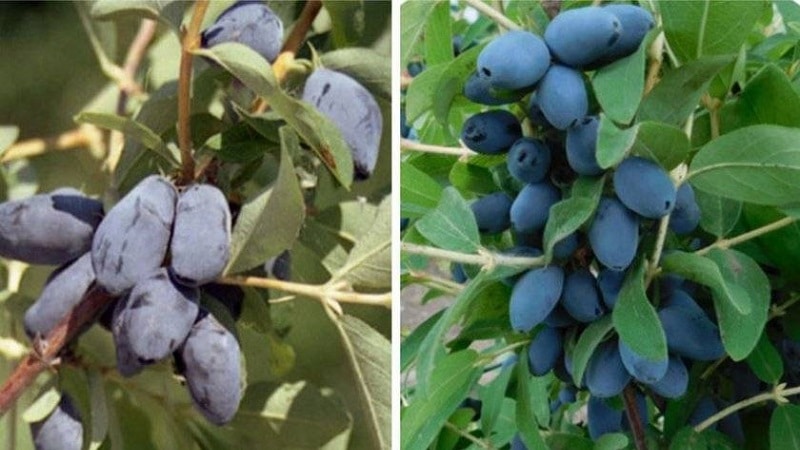
Resistance to diseases and pests
A plant with strong immunity has persistent resistance to bacterial and viral infections.However, with pests the situation is different. Aphids become a serious danger to the dense crown of shrubs.
Important! A small insect that feeds on the cell sap of young leaves and green shoots can cause great damage. Damaged parts of the plant begin to deform and dry out, and the fruits begin to fall off prematurely.
To get rid of the pest, experienced summer residents use infusions of fragrant and bitter herbs:
- celandine;
- tansy;
- sagebrush;
- dandelion, etc.
If insect colonies have reached catastrophic sizes, chemical insecticides are used: Inta-vir, Sumi-Alpha, Decis Profi, Actellik, etc.
Resistance to cold and drought
Bred in the Altai Territory from zoned varieties, Berel honeysuckle withstands spring return frosts. In addition, the plant overwinters safely without special shelter.
The shrub easily tolerates short-term drought, but a prolonged lack of moisture reduces yield.
Important! To ensure high-quality fruiting, the plant is watered abundantly in hot weather.
For which regions is it best suited and what are the climate requirements?
The honeysuckle variety, bred by breeders from the Siberian Horticulture Research Institute, has been zoned for regions with harsh climates. An unpretentious and cold-resistant plant can more easily tolerate frosts of 30-35°With than summer heat and prolonged drought.
The main advantages and disadvantages of the variety
Breeders used 3 original varieties in their work (Blue bird, Azure, Blue Spindle). From each of these plants, Berel honeysuckle inherited the best varietal qualities:
- ease of care;
- strong immunity;
- pest resistance;
- early flowering and fruiting;
- frost resistance.
In addition, the garden crop is highly decorative due to its luxurious bright green crown, fragrant inflorescences and large berries. In addition, Berel is an excellent honey plant. Thanks to this, there are no problems with pollinating insects during the flowering period.
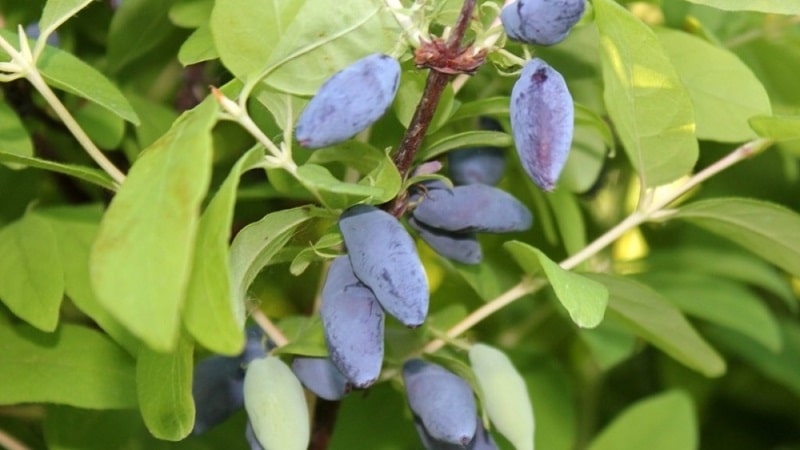
The only drawback of the variety is its self-sterility. For high-quality pollination, the plant is planted in a group of related crops.
Attention! In group plantings, you should not plant bushes close to each other. Dense thickets, in which the movement of air masses is difficult, become a favorable environment for the development of fungal infections and the proliferation of pests.
What is the difference from other varieties and hybrids
Many varieties of honeysuckle have been bred for regions with harsh climates. Some of them are in some ways inferior to the Berel variety, and some are superior to it:
- Siberian - an early-ripening crop that forms a spherical crown. The yield per bush barely reaches 2.5 kg.
- Fire Opal is a low-growing shrub that easily tolerates temperature changes and is famous for its stable yield (about 6 kg).
- Morena - the plant produces large sweet and sour fruits, but their yield does not exceed 2 kg per bush.
- Narymskaya - the main distinguishing feature is that fruiting begins already in the second year after planting the seedling in a permanent place.
- Sorceress - easily tolerates heat and drought. However, overripe fruits that are not collected in time fall off.
By taste qualities Honeysuckle Berel is superior to the following varieties: Kingfisher, Kumikovka, Slavyanka. The fruits of these plants are characterized by increased sugar content. And in terms of berry size it is ahead of other varieties: Bakcharsky Velikan, Violet, Shahinya. Their oblong fruits reach a length of up to 4 cm.
Agricultural technology
For good fruiting, a berry bush needs to create favorable conditions. The qualitative and quantitative indicators of the harvest directly depend on competent agricultural technology.
Choosing a place in the garden and preparing holes
Perennial bush prefers well-lit areas, protected from cold winds. It can also be grown in shade, but in this case the berries will be more sour than those ripened in the sun.
The plant should not be planted in places with close groundwater - it cannot tolerate stagnant moisture in the soil. In a wetland there is a high risk of rotting of the root system.
Preparing for landing
Planting holes are prepared in advance (30 days before the event). The bottom of the pit (at least 1 m deep) is lined with a drainage layer of pebbles, crushed stone or broken brick - this will ensure a good drainage of excess moisture.
Important! It is better to purchase seedlings from nurseries with a closed root system. The earth ball will provide the plant with rapid adaptation and survival in a new place.
Soil requirements
Berry bush prefers loose, fertile soil with good permeability. To improve the structure of the soil and increase fertility, humus, compost and mineral complex fertilizers are added to it.
Dates, scheme and rules of planting
Plants with early vegetation, which include Berel honeysuckle, are recommended plant in autumn. This work is carried out in mid-September - early October. Based on the weather forecast, the event is held 2-3 weeks before the onset of stable frosts.
Wherein planted up to 4 bushes of different varieties at the same time, leaving a distance of at least 1.5 m between them. The seedlings are carefully placed in the holes, straightening the roots so that there are no creases.The holes are filled with soil enriched with humus and minerals and lightly compacted. The planting site is watered abundantly at the rate of 15-20 liters of water per 1 bush.
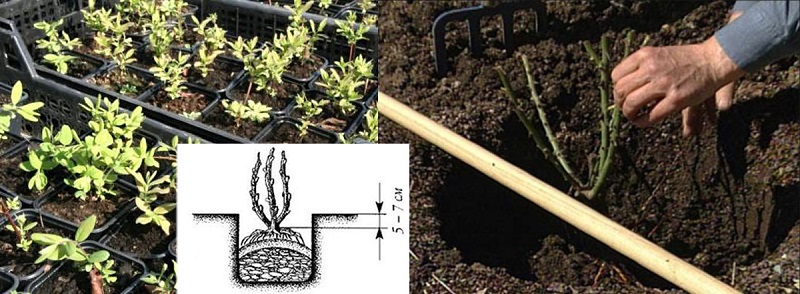
Features of cultivation
Garden honeysuckle Berel needs standard care: timely watering, loosening and mulching of the soil.
In addition, adult plants are annually pruned.
Nuances of care
Young seedlings 1-2 years old need adaptation and development of the root system. After the plant reaches 3 years of age, it begins to be pruned. Sanitary pruning is carried out to remove old, diseased, dry or damaged shoots.
In addition, it is important trim stems that thicken the crown because they reduce yield. The pruning procedure gives the bush a neat appearance, rejuvenates it and prolongs its fruiting period. In addition, the compact crown makes it easier to care for and harvest.
Young bushes up to 2 years of age do not feed. The fertilizers applied when planting the plant are sufficient for this period. From the age of 3-4 years, Berel begins to bear fruit. In this case, the bush will be in dire need of nutrients. From this time on, they begin to feed it, alternating complex mineral fertilizers with organic matter.
Pollinators
For quality pollination Self-fertile varieties of honeysuckle are planted near Berel: Gerda, Siberian, Morena, Enchantress and etc.
Each group should have at least 4 plants planted at intervals of 1.5-2 m.
Disease and pest control
Unpretentious culture practically does not get sick and is rarely affected by pests. Therefore, there is no particular need for treatment with pesticides. For the purpose of prevention, the shrub is treated with an infusion of garlic and wormwood.
To prepare the composition, 200-250 g of garlic and a large bunch of wormwood are crushed and then poured with a bucket of warm water. This mixture is left to infuse in a warm place for 24 hours.
Before spraying, filter the product and treat the bushes twice a month (before fruiting) with an interval of 2 weeks.
Preparing for winter
IN frost protection Only young seedlings up to 3 years old need it. 2-3 weeks before the cold weather, the plant is watered abundantly and the soil in the tree trunk is mulched with humus, compost or peat. Spruce branches are laid on top of this layer (10-15 cm).
Reproduction
The garden crop is easily propagated by seeds and layering. However, the fastest and most effective method is green cuttings. To do this, young shoots are torn from the mother bush, treated with a growth stimulator and planted in wet soil.
Important! All leaves at the bottom of the cutting are removed, and those remaining on the top are shortened by half. This will reduce moisture evaporation and speed up the rooting process.
Harvesting
Honeysuckle Berel is one of the few varieties in which even overripe berries do not fall off the bush. This is a great convenience for summer residents who come to the site only on weekends.
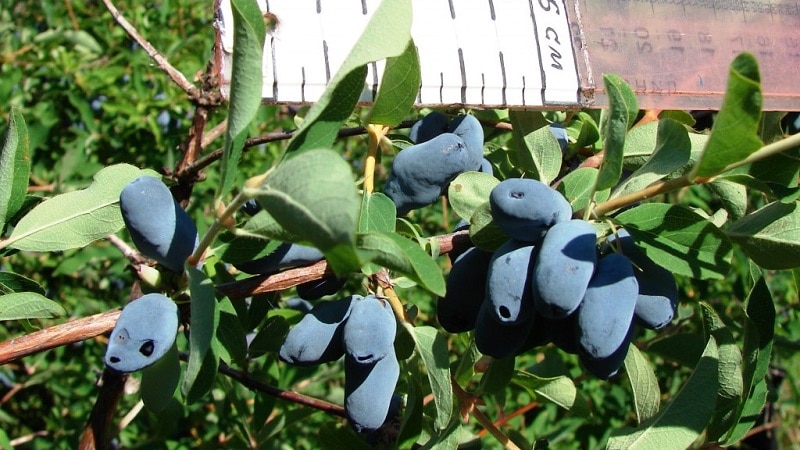
How and when to collect
In temperate climates the harvest is being harvested at the end of June, and in regions with more severe weather conditions - 2-3 weeks later. The berries are collected manually, and in exceptional cases (growing for sale) - with special combines.
What difficulties may there be when growing
The unpretentious plant does not create problems for owners of summer cottages. Until the age of 3, the shrub develops slowly, as it goes through a period of adaptation: the plant builds up a powerful root system.
If a crop older than 3 years is lagging in growth and has not begun to bear fruit, you should pay attention to the composition and structure of the soil, watering and fertilizing regime.
Tips and reviews from experienced gardeners about the variety
Nikita Bakun, Ekaterinburg: “I have been growing this crop for a very long time. Since the dacha is located far outside the city, I go there only on weekends. I didn’t choose the Berel variety by chance: I like the unpretentiousness of the plant and the taste of the berries.”.
Olesya Mironenko, Orenburg: “I have been breeding different varieties of honeysuckle for about 10 years. I buy seedlings at the nearest nursery. Berel is my favorite and doesn't require much care. In addition, the berries ripen early, when other plants are not yet bearing fruit.”.
Conclusion
An unpretentious, cold-resistant crop is easy to grow even for novice gardeners. In addition, the shrub, which requires minimal care, is an excellent decor for a summer cottage and a valuable storehouse of vitamins and microelements.